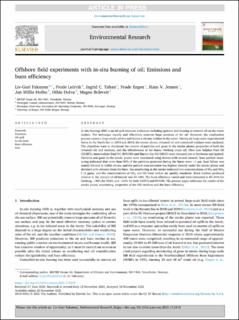| dc.contributor.author | Faksness, Liv-Guri | |
| dc.contributor.author | Leirvik, Frode | |
| dc.contributor.author | Taban, Ingrid C. | |
| dc.contributor.author | Engen, Frode | |
| dc.contributor.author | Jensen, Hans V. | |
| dc.contributor.author | Holbu, Jan Willie | |
| dc.contributor.author | Dolva, Hilde | |
| dc.contributor.author | Bråtveit, Magne | |
| dc.date.accessioned | 2022-08-10T07:18:30Z | |
| dc.date.available | 2022-08-10T07:18:30Z | |
| dc.date.created | 2021-12-23T12:01:41Z | |
| dc.date.issued | 2021 | |
| dc.identifier.citation | Environmental Research. 2021, 205, 1-10. | en_US |
| dc.identifier.issn | 0013-9351 | |
| dc.identifier.uri | https://hdl.handle.net/11250/3010966 | |
| dc.description.abstract | In situ burning (ISB) is an oil spill response technique including ignition and burning to remove oil on the water surface. The technique rapidly and effectively removes large portions of the oil. However, the combustion process causes a large smoke plume and leaves a viscous residue in the water. During six large-scale experimental burns in the North Sea in 2018 and 2019, the smoke plume, released oil and contained residues were analysed. The objectives were to document the content of particles and gases in the smoke plume, properties of both the released oils and residues, and the effectiveness of the burns. Oseberg crude oil, Ultra Low Sulphur Fuel Oil (ULSFO), Intermediate Fuel Oil (IFO180) and Marine Gas Oil (MGO) were released into a fire-boom and ignited. Particles and gases in the smoke plume were monitored using drones with several sensors. Soot particle monitoring indicated that more than 90% of the particles produced during the burns were <1 μm. Soot fallout was mainly limited to visible smoke, and the particle concentration was highest directly under the smoke plume and declined with distance from the burn. Gas monitoring in the smoke indicated low concentrations of SO2 and NOX (<2 ppm), and the concentrations of CO2 and CO were within air quality standards. Black Carbon produced relative to the amount of oil burned was 10–18%. The burn efficiency varied and were estimated to 80–91% for Oseberg, >90% for MGO, and <60% for both ULSFO and IFO180. The present paper addresses the results of the smoke plume monitoring, properties of the ISB residues and the burn efficiency. | en_US |
| dc.language.iso | eng | en_US |
| dc.publisher | Elsevier | en_US |
| dc.rights | Navngivelse 4.0 Internasjonal | * |
| dc.rights.uri | http://creativecommons.org/licenses/by/4.0/deed.no | * |
| dc.subject | Soot | en_US |
| dc.subject | Burn efficiency | en_US |
| dc.subject | In situ burn | en_US |
| dc.subject | Oil spill | en_US |
| dc.subject | Emissions | en_US |
| dc.title | Offshore field experiments with in-situ burning of oil: Emissions and burn efficiency | en_US |
| dc.type | Peer reviewed | en_US |
| dc.type | Journal article | en_US |
| dc.description.version | publishedVersion | en_US |
| dc.rights.holder | © 2021 The Authors. Published by Elsevier Inc. | en_US |
| dc.source.pagenumber | 1-10 | en_US |
| dc.source.volume | 205 | en_US |
| dc.source.journal | Environmental Research | en_US |
| dc.identifier.doi | 10.1016/j.envres.2021.112419 | |
| dc.identifier.cristin | 1971716 | |
| dc.source.articlenumber | 112419 | en_US |
| cristin.ispublished | true | |
| cristin.fulltext | original | |
| cristin.qualitycode | 2 | |

